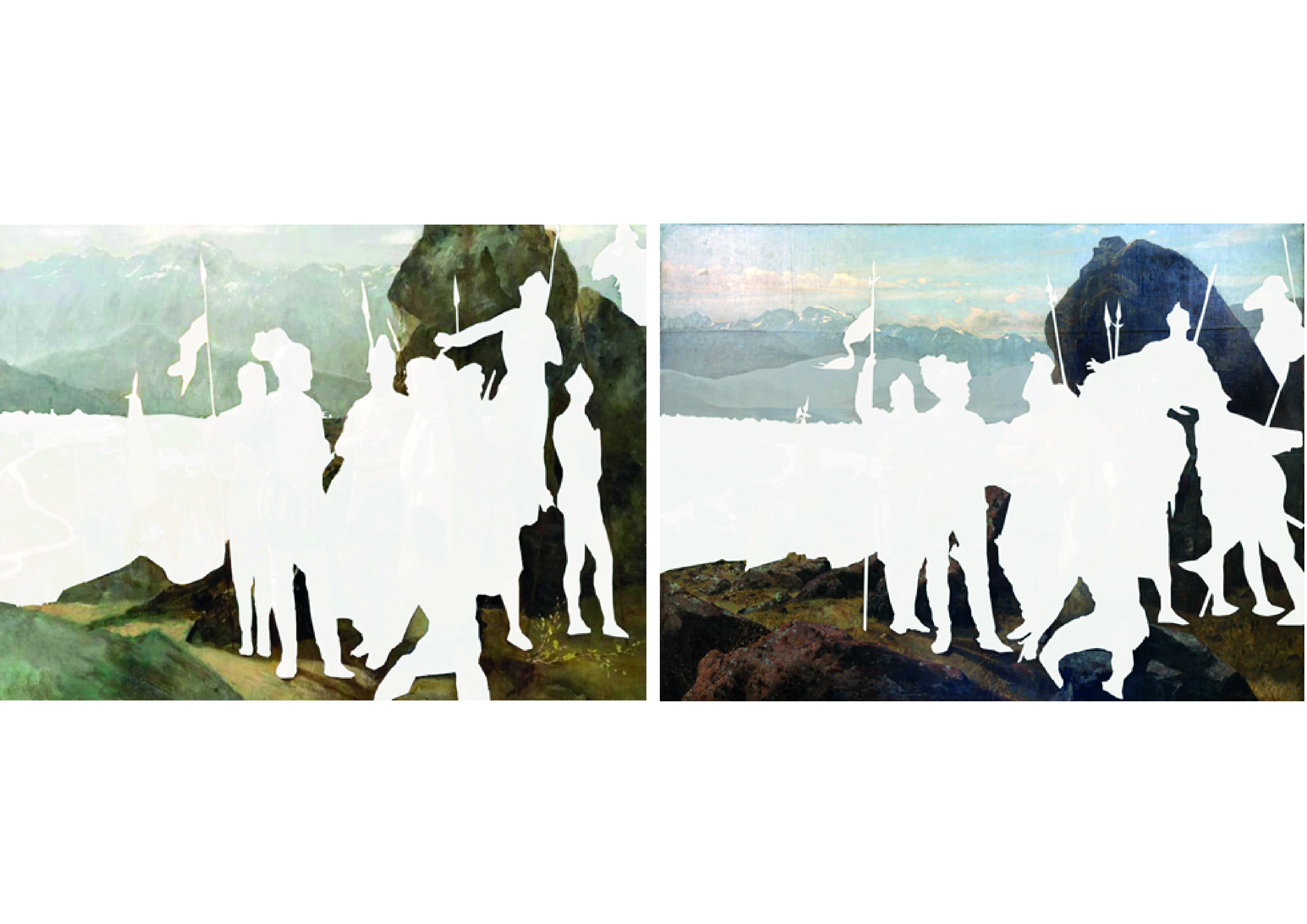Two Paintings, Two Landscapes
One Foundational Act The Foundation of Santiago and the Construction of a Landscape Imaginary
DOI:
https://doi.org/10.18861/ania.2025.15.1.4038Keywords:
Landscape, identity, National imaginary, pictorial representation, Santiago de ChileAbstract
The analysis of the initial and final versions of The Foundation of Santiago, created by Pedro Lira Rencoret at the end of the 19th century, may prove illuminating for approaching the origins of the construction of a national landscape imaginary in Chile. The work, which represents the foundational act of the city of Santiago, is presented in two moments: a study version and, subsequently, a definitive version, constituting notably different interpretations of the same historical event.
Landscape representation in Chile reached its maximum development during the 19th century, a period when the landscape genre was consolidated as a fundamental tool in the construction of Latin American national identities. In this context, Lira's work acquires special relevance by presenting two contrasting visions of the same territory: the study version, which approaches a more faithful representation of the Mapocho valley during the conquest, and the final version, which constructs an idealized image that responds to the aspirations of the 19th-century Chilean nation.
The present research proposes a detailed comparative analysis of both versions, decomposing their landscape elements to examine the construction of two distinct narratives that have influenced the way of culturally conceiving Chilean territory and identity. The study suggests that the differences between both versions reveal the tensions and aspirations present in the construction of 19th-century Chilean national identity.
This analytical exercise invites deeper reflection on the process of decolonization of the original landscape, examining how pictorial representations not only document a historical moment but also actively participate in the construction of national and cultural imaginaries.
Downloads
References
Blanco, J. M. (1885-1889). El Taller Ilustrado (Obra completa). Santiago, Chile. https://www.memoriachilena.gob.cl/602/w3-article-8612.html
Collados, M. (1988). Formas de vida para Chile. Zigzag.
De la Maza, J. (2013). De géneros y obras maestras: La Fundación de Santiago (1888) de Pedro Lira. Caiana. Revista de Historia del Arte y Cultura Visual del Centro Argentino de Investigadores de Arte (CAIA), (3). Recuperado de https://caiana.caiana.com.ar/wp-content/uploads/2023/05/De-LA-MAZA.pdf
De Rosa Giolito, E. R. (2023). Puesta en valor del patrimonio portuario para una mejora del paisaje: El cine en la Bahía de Pasaia. Transporte y Territorio, (29), 92-112. https://doi.org/10.34096/tt.i29.12664
Errázuriz, R. (1885). A propósito del salón de 1885. En Revista de artes y letras (Tomo 5). [s.n.]. https://www.memoriachilena.gob.cl/602/w3-article-81917.html
Faba Zuleta, P. (2016). Cultura visual y memoria en el Chile del siglo XIX. Redefiniendo el coloniaje a través de su exhibición. Revista De Teoría Del Arte, (24), 13-33. https://revistateoriadelarte.uchile.cl/index.php/RTA/article/view/38460
López, A. (2016). Los códigos secretos de "La Fundación de Santiago". https://es.scribd.com/doc/311664891/Lopez-Tapia-Alexis-Los-Codigos-Secretos-de-La-Fundacion-de-Santiago
Jara, F. (s.f.). Identidad nacional a través del conocimiento del paisaje y territorio: Chile en el siglo XIX. Documentos Arte Chile UAH. https://documentosartechile.uahurtado.cl/tema/identidad-nacional-a-traves-del-conocimiento-del-paisaje-y-territorio-chile-en-el-siglo-xix/
Maderuelo, J. (2005). El paisaje: génesis de un concepto. Abada.
Museo Nacional de Bellas Artes. (2017). El bien común. https://www.mnba.gob.cl/617/articles-80694_archivo_01.pdf
Naranjo Ramírez, J. (2006). Esencia y forma de los paisajes campiñeses: Aproximación desde la geografía. Patrimonium, (0), 8-21.
Ovalle, A. (1646). Historica relacion del Reyno de Chile y de las misiones y ministerios que exercita en la Compañía de Jesus. Por Francisco Cavallo.
Parra, N. (1969). Obra gruesa. Editorial Universitaria. https://www.memoriachilena.gob.cl/602/w3-article-8612.html
Plataforma Urbana. (2015, 8 de julio). Río Mapocho: Agua que se pierde en la tierra. https://www.plataformaurbana.cl/archive/2015/07/08/rio-mapocho-agua-que-se-pierde-en-la-tierra/
Schama, S. (1995). Landscape and Memory. Alfred A. Knopf.
Schoennenbeck Grohnert, S. (2013). Paisaje, nación y representación del sujeto popular: Visiones de un Chile imaginado. Aisthesis, (53), 73-94. https://dx.doi.org/10.4067/S0718-71812013000100004
Vilà i Tomàs, L. (2003). Épica e imperio: Imitación virgiliana y propaganda política en la épica española del siglo XVI [Tesis doctoral]. Universitat Autònoma de Barcelona. https://dialnet.unirioja.es/servlet/tesis?codigo=4562
Villoro, L. (1999). Del Estado homogéneo al Estado plural. Revista Latinoamericana de Derecho, 113-130. https://archivos.juridicas.unam.mx/www/bjv/libros/1/98/6.pdf

Published
How to Cite
Issue
Section
License
Copyright (c) 2025 José Antonio Sánchez Toro, Reinaldo Chong Vega

This work is licensed under a Creative Commons Attribution 4.0 International License.
The journal and its contents are licensed under the Creative Commons - Attribution 4.0 International License (CC BY 4.0). It is possible to copy, communicate and publicly distribute its content as long as the individual authors and the name of this publication are cited, as well as the publishing institution (Universidad ORT Uruguay).

